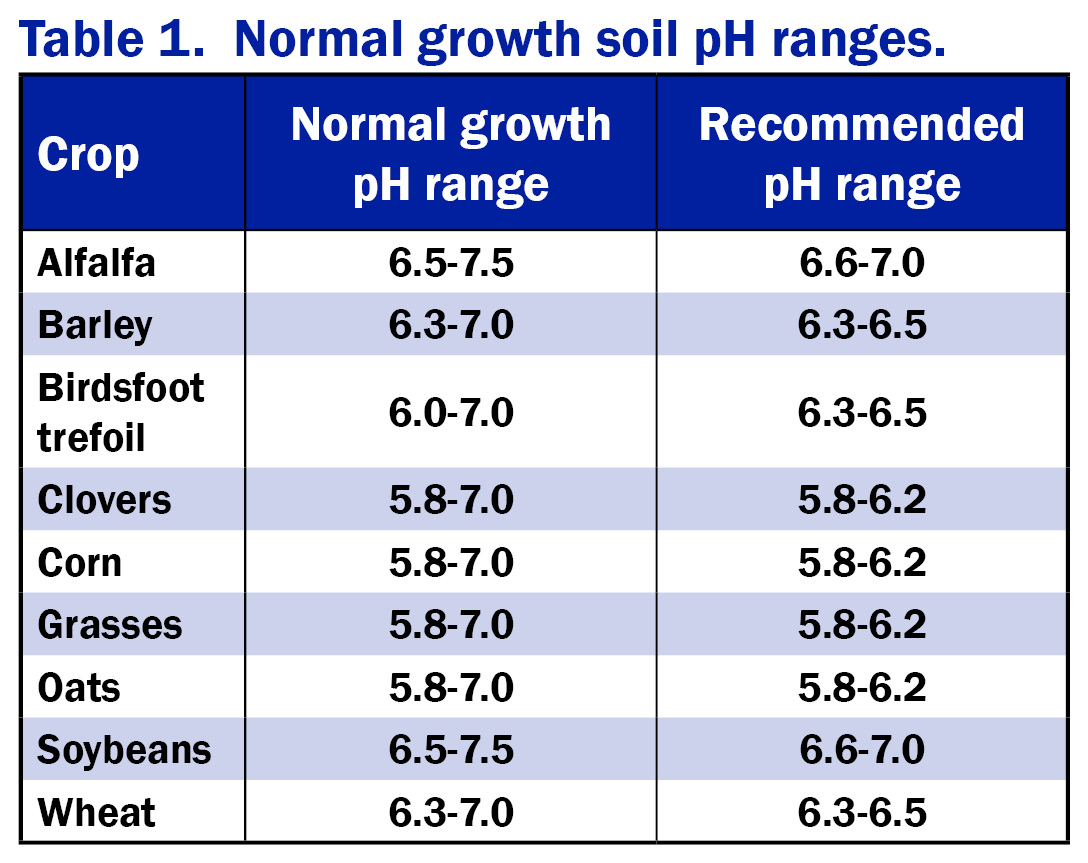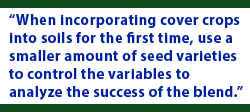
What’s the best crop for my soil?
 By Steve Murty, Vita Plus forage products specialist
By Steve Murty, Vita Plus forage products specialistCustomers ask this question each year before planting season, and it may still be asked several times per year on the same acre. To answer this monumental question, let’s examine several components that make up the soil environment, including soil pH, water holding capacity and yield goals.
Soil pH
Soil pH generally ranges from extremely acidic (pH of 3) to very alkaline (pH of 10), depending on the soil’s parent material and the amount of annual rain fall. Soil pH directly affects nutrient availability for the plant. The graph on page one of this document shows nutrient availability at specific pH ranges. The wider the bar, the more available that nutrient is for the plant at that pH. A low pH reduces the availability of macro- and secondary nutrients, while a high pH reduces the availability of most micronutrients.
A high or low pH may also reduce or change microbial activity. An application of limestone or commercially manufactured pelletized lime can raise the acidic soil to a more ideal range. Local extension agencies or university agronomists can help determine an ideal application of lime utilizing local lime neutralization equations.
 Table 1 outlines normal growth pH ranges for common forage crops. When a crop is planted into a soil pH outside of its normal range, additional products will be required to correct the soil pH or another cultivar should be selected to handle either an acidic or alkaline soil.
Table 1 outlines normal growth pH ranges for common forage crops. When a crop is planted into a soil pH outside of its normal range, additional products will be required to correct the soil pH or another cultivar should be selected to handle either an acidic or alkaline soil.
Proper timing and placement of fertilizer can also help mitigate soil pH. Understanding when a forage crop’s macro- and micronutrient peak uptake periods occur can help predict proper timing of fertilizer.
Water-holding capacity
Soil water-holding capacity can be viewed from two extremes:
- Excessive water retention: One solution to soils that retain a lot of water is to have adequate drainage installed; another solution is to select a crop more tolerant to damp soil conditions. Perennial grasses, once established, can handle damp soils for an extended time period. One thing to note is excessive water retention may influence soil pathogen growth. Alfalfa breeding programs continue to release new varieties with increased Aphanomyces tolerance. Aphanomyces is a seedling root disease more prevalent in damp soils.
- Lack of water-holding capacity: Soils prone to drought require a crop that can handle longer periods of dry conditions. Summer annuals like sorghum, sudangrass, millet and teff all have natural drought tolerance. They sustain similar production with one-third less water.
Yield goals
Yield goals should be realistic for your soil and environment. To maximize tons or bushels for the soil type, multiple plantings per year can be considered. Understanding the total growing degree units accumulated for a growing season will help decide the best forage crop to plant on the acre.
Cover crops continue to gain momentum across thousands of acres. Growing cover crops provides additional forage to feed and improves soil health while maintaining a continual green acre during the season.
Cover crops have also become a popular way to create in-field TMR cocktails. Research has proven multi-species cultures create a synergy in the growing environment compared to a monoculture environment. To help decide the optimal blend for the acre, it helps to review the forage species growth patterns, and, when incorporating cover crops into soils for the first time, use a smaller amount of seed varieties to control the variables to analyze the success of the blend.
 If you are building an in-field TMR cocktail, remember different forage species will prefer different seeding windows and soil temperatures, pH, fertilities, and water holding capacities, especially during the seeding phase. However, once established, creating a blended in-field TMR can eliminate several of the growth peaks and valleys throughout the seasons. Keep in mind, creating an ideal in-field TMR can also be challenging due to the forages’ competitive growing characteristics. Over time, one forage crop will become a higher percentage of the in-field TMR.
If you are building an in-field TMR cocktail, remember different forage species will prefer different seeding windows and soil temperatures, pH, fertilities, and water holding capacities, especially during the seeding phase. However, once established, creating a blended in-field TMR can eliminate several of the growth peaks and valleys throughout the seasons. Keep in mind, creating an ideal in-field TMR can also be challenging due to the forages’ competitive growing characteristics. Over time, one forage crop will become a higher percentage of the in-field TMR.
Now back to the question… “What is the best crop for my soil?”
We first need to break down the soil environment into smaller segments. By identifying the basic needs in soil biology, we can move down the path to find the right crop for your soil. Careful planning prior to planting will help ensure every acre reaches its full yield potential.
| Category: |
Crop varieties Forage Foundations Forage harvesting Soil health |

